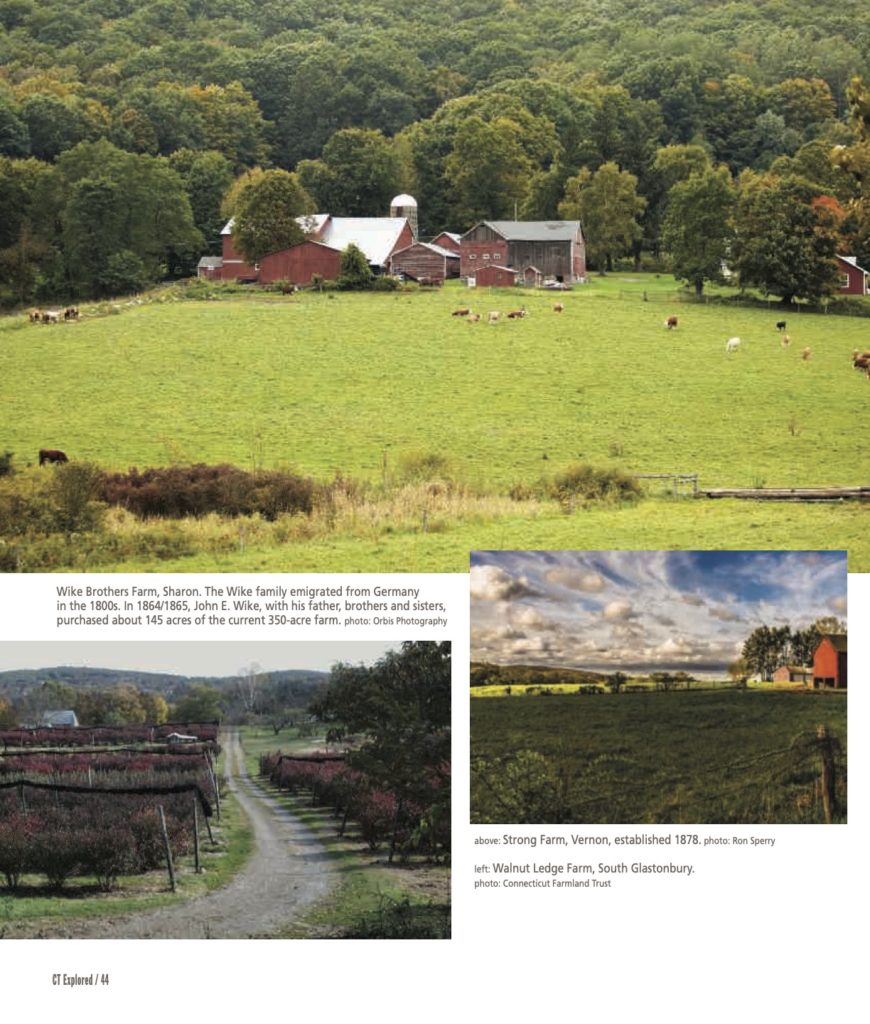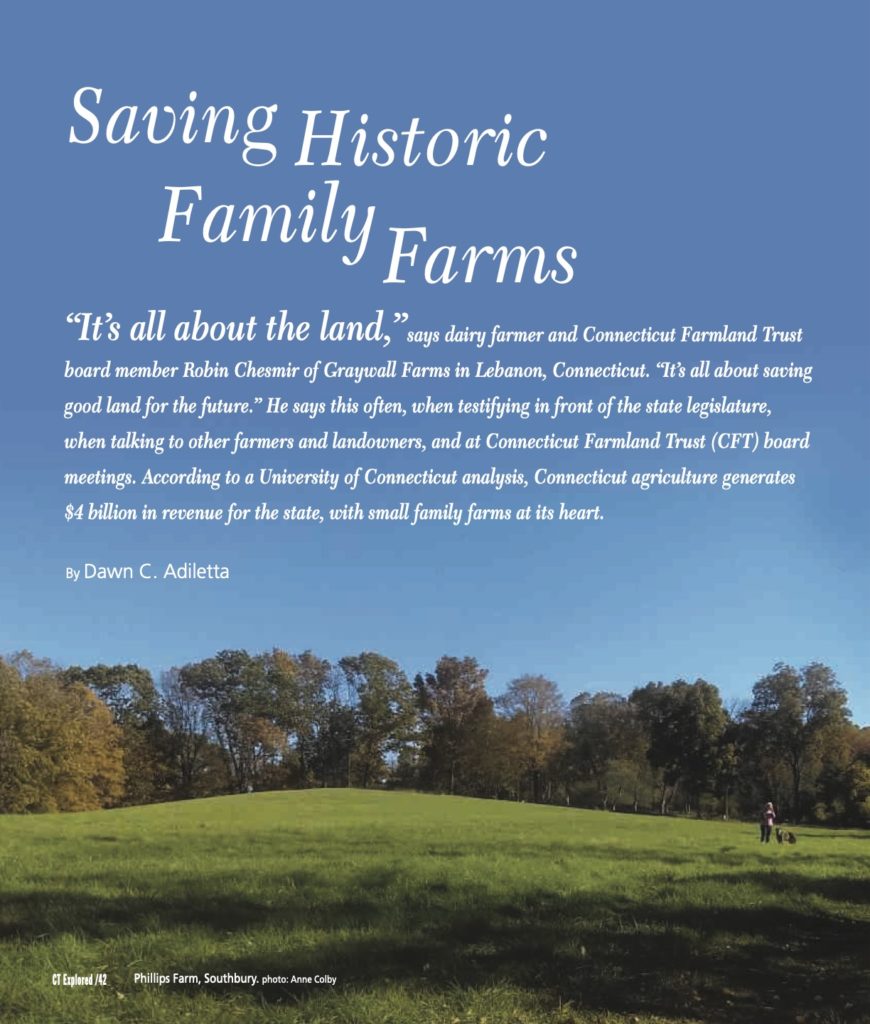By Dawn C. Adiletta
(c) Connecticut Explored Inc. Spring 2021
Subscribe/Buy the Issue!
“It’s all about the land,” says dairy farmer and Connecticut Farmland Trust board member Robin Chesmir of Graywall Farms in Lebanon, Connecticut. “It’s all about saving good land for the future.” He says this often, when testifying in front of the state legislature, when talking to other farmers and landowners, and at Connecticut Farmland Trust (CFT) board meetings. According to a University of Connecticut analysis, Connecticut agriculture generates $4 billion in revenue for the state, with small family farms at its heart.
But saving those small family farms—some of which are historic and have been in families for generations—has not always been something local land trusts were interested in. As CFT Executive Director Elisabeth Moore explains, “We filled a niche. In 2000, most land trusts weren’t protecting farmland, and many of those who did viewed agriculture as a side benefit of protecting open spaces. Furthermore, state and federal programs prioritized larger properties, making it difficult to protect smaller farms. We were losing small farms to development because few conservation options were available.” CFT was incorporated in 2002 to protect working lands for future generations of farmers and to save farmland that other conservation agencies would not.
CFT’s first project, in South Glastonbury, reflected those concerns. Elsie Scaglia wanted to sell her 16-acre berry farm and orchard yet keep it in agriculture, but her parcel was too small for existing state preservation programs. CFT’s easement allowed the valuable farmland to be sold to its current owners Michael and Joanna Kamis. The Kamis family, who renamed the site Walnut Ledge Farm, have farmed there for seven years, posting on their website their goal to “develop a healthy environment to grow delicious food” and raise their two young daughters.
Today CFT protects nearly 5,000 acres in Connecticut consisting of more than 60 farms ranging from just under 5 acres to more than 210 acres. Twenty-five per cent are under 35 acres, reflecting CFT’s original purpose of protecting small farms.
Even though some of Connecticut’s 137 land trusts now also protect farmland, CFT remains the only state-wide land trust dedicated specifically to protecting working lands, which are best described as lands producing food or fiber, generating crops for livestock, or growing commercial plants. CFT is different from most land trusts, too, in that it does not own any land; instead it holds agricultural conservation easements. All land trusts use conservation easements, but because owning land outright makes it easier to protect, most land trusts now prefer land be conveyed to them. Conservation easements occur when a land owner donates or sells the right to develop land to a government agency or land trust, but the property itself remains in private hands. This allows owners to continue to live on the land or sell it, but the land remains protected. In addition, since most CFT-protected farms are private property, they stay on town tax rolls, continuing to contribute to local grand lists.
Like traditional conservation easements, agricultural easements restrict most development, but they permit limited construction of agricultural buildings and the continued use of the land for agricultural production. This is an important distinction. According to the Natural Resource Conservation Service (NRCS), agricultural easements provide the benefits of maintaining open-space and wildlife habitats while also helping to “protect the long-term viability of the nation’s food supply by preventing conversion of productive working lands to non-agricultural uses.”

top: Wike Brothers Farm, Sharon. The Wike family emigrated from Germany in the 1800s. In 1864/1865, John E. Wike, with his father, brothers and sisters, purchased about 145 acres of the current 350-acre farm. photo: Orbis Photography; right: Strong Farm, Vernon, established 1878. photo: Ron Sperry; below: Walnut Ledge Farm, South Glastonbury. photo: Connecticut Farmland Trust
The Value of Farmland Preservation
What most of us think of as local farms, farmers markets, and farm stands, officials consider critical to our nation’s food security. Connecticut is not now, nor has it historically been, self-sufficient when it comes to food, but one only has to consider the vineyards destroyed in west-coast wildfires, Mississippi River floods that prevented Midwest planting, or pandemics that delayed timely harvests to see the wisdom of expanding our food sources. Local foods diversify food supplies, improve inner-city access to fresh foods, and reduce emissions caused by lengthy transports. In addition, the 2020 Connecticut Department of Energy and Environmental Protection (DEEP) report on climate change describes the added environmental values of farmland preservation of wildlife habitat preservation, flood control, carbon sequestration, and historic preservation.
Moore observed that CFT has become increasingly aware of farmland’s important role in reducing atmospheric carbon and mitigating the impact of more frequent heavy rainfalls. Farmland naturally acts as a carbon sink—literally a physical place where carbon is absorbed from the atmosphere and stored. Using no-till practices and planting cover crops increases carbon absorption, which in turn maintains healthy soils that are better at absorbing water and reducing run-off. These practices can also reduce agricultural emissions, making an investment in farmland an investment in our future.
Farmland preservation can also safeguard historic landscapes. The 156-acre McCaw farm on Lebanon’s historic green once belonged to Jonathan Trumbull Jr. (governor of Connecticut, 1797 – 1809) and encircles his 1700s home which is now a museum. Across the green, the 35-acre Wayland farm contributes to the rural environment close by the Jonathan Trumbull Sr. House (governor of Connecticut, 1776 – 1784) and War Office, also a museum. [See “The Trumbull Dynasty,” Fall 2010, “Connecticut’s Colonial Town Green,” Spring 2012, and “Who Owns Lebanon’s Town Green?,” Summer 2019.]
Like all land trusts, CFT has preservation partners, including the Connecticut Department of Agriculture (CT DoAg), NRCS, like-minded land trusts, and individual towns. For instance, in 2004, the Southbury Land Trust donated an agricultural easement on Phillips Farm in Southbury to CFT. The farm, once the home of writer Gladys Taber, contains old-growth forest, working lands, several historic agriculture buildings, and an early 18th-century farmhouse. The Southbury Land Trust knew partnering with CFT would help ensure that much of Phillips Farm would remain available for agriculture.
Most CFT-protected lands are family-owned farms. Sometimes the family is new to the property, but sometimes the family has been connected to the land for centuries. In Voluntown, on Connecticut’s eastern border, 13 generations of Gallups have worked their 500-acre homestead since the 1600s. Currently a wholesale dairy operation, Byron Gallup decided to protect his land when he realized no one from the next generation was interested in farming. Gallup’s actions ensure that the large farm will remain available to future farmers. “Protecting these farms means protecting prime agricultural land—as well as a piece of history,” said Elisabeth Moore.
For Future Generations of Farmers
As new generations of Connecticut farmers focus on direct sales to local buyers instead of distant wholesale markets, the demand for smaller farms has increased. In response, CFT began protecting land differently. In the past CFT often used a single easement to cover a large farm, which meant it could not be subdivided. Now, depending on the owner’s plans, CFT might place multiple easements on a property, allowing an owner to sell smaller, more affordable parcels off to new farmers, but still guaranteeing the land will be protected. This is how the Gallups chose to protect their farm and farming legacy. To facilitation this work, in 2018 CFT assumed management of Connecticut FarmLink, a local affiliate of a national website that helps farmers and would-be farmers find farmland. Tongue-in-cheek, Moore describes it as Match.com® for farmers and land.
Liz MacAlister of Colchester and her son Mark Gilman of Cato Corner Farm are national award-winning cheesemakers producing farmstead raw milk cheeses since 1997. MacAlister protected their 75-acre farm in stages, first selling an easement on the grasslands and pasture to NRCS to provide needed business capital, then donating an additional easement on the entire property to CFT to ensure that the farm land and agricultural infrastructure critical to the operation’s sustainability remain united.
Enabling family-run farms is an important added value of CFTs work. From Watertown to Woodstock and Canton to Colchester, new farmers and historic multi-generational farming families work hard. As Tim Abbott of the Housatonic Valley Association, a CFT preservation partner, said in a June 26, 2000 interview in the Litchfield County Times, “sustaining farm families is the most difficult thing to achieve in land preservation.” Through its work, CFT supports farm families, promotes local food production, and even combats global warming. But in its heart, its work will always be all about the land.
Dawn Adiletta, a retired museum curator, is a free-lance writer active in farmland preservation. For Connecticut Explored she most recently wrote “Connecticut’s Hopyards,” Summer 2017.
Explore!
Connecticut Farmland Trust
ctfarmland.org
This is one in a series of stories funded in part by Hartford Foundation for Public Giving about the history of nonprofits that operate in the Greater Hartford region.
GO TO NEXT STORY
Read more stories about the historic Connecticut landscape on our TOPICS page.
“Hebrew Tillers of the Soil,” Spring 2006
SUBSCRIBE to receive every issue!
Sign up for our free bi-weekly e-newsletter

